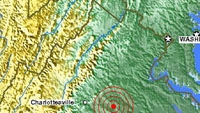East Coast earthquake shows stability of OTA broadcasts

A 5.8 magnitude earthquake shook people up and down the east coast of the U.S. (from North Carolina to Massachusetts and west to Chicago) on Tuesday, causing some minor interruptions in cellular network service due to heavy network (calling and texting) traffic.
The NAB used the event, which was centered in small Mineral, VA, to beat the drum for spectrum policy advocacy and allowing broadcasters to keep their full 6 MHz of spectrum.
“Policymakers debating spectrum policy ought to take note that the one reliable communications service during today's earthquake was the original wireless technology - free and local broadcasting,” said Dennis Wharton, NAB Executive Vice President of Communications. “It’s easy to get dazzled by iPads and Smartphones, but all the spectrum in the world won’t ensure reliability of the ‘one-to-one’ cellphone network architecture during an emergency.
“When there’s a crisis, it’s hard to replicate the reliability of the 'one-to-everyone' local radio and TV broadcast signal.”
The earthquake lasted less than a minute, but caused some live TV shows, such as MSNBC’s “Andrea Mitchell Reports” to shut down as her third-floor studio, anchor desk and papers began shaking while on the air. The staff was evacuated from the MSNBC building in Washington DC, but everyone returned within an hour.
“The cameras were shaking,” Mitchell reported shortly after it happened.
Another AccuWeather meteorologist was taping a weather segment (for the South Dakota market) in the company’s studios in State College, Pa., when the lights in the studio began to shake. Video footage shows her getting visibly nervous and pointing out the swaying lighting rig in the studio as the ground shook.
The professional video industry's #1 source for news, trends and product and tech information. Sign up below.
Immediately after the earthquake, some people reportedly were unable to place calls in New York City using AT&T and Sprint smart phones, as well as office landlines. Service appeared to be restored in New York City within the hour.
Verizon Wireless released a statement on Twitter that read: “Seeing no reports of damage to our wireless network. There was some network congestion in the East after tremors. Continuing to monitor.”
An email from T-Mobile to the website http://www.engadget.com/ stated: “T-Mobile’s network is experiencing higher call volumes in all areas and counties affected by the earthquake. If customers are experiencing temporary difficultly placing calls due to network congestion, we advise them to use SMS or E-Mail until call volumes return to normal.”
They eventually did return to normal and all callas were going through a short time later.
